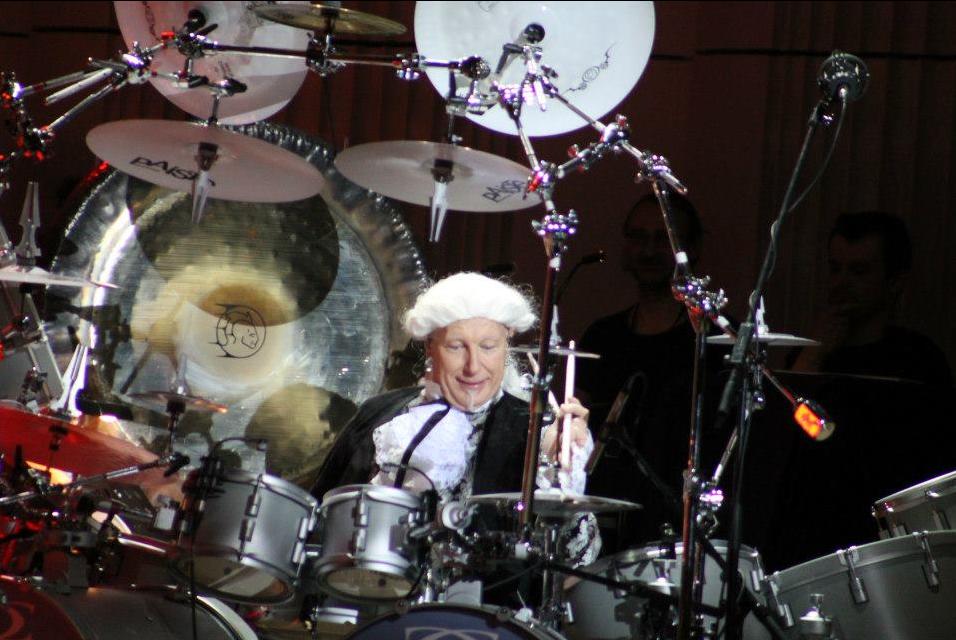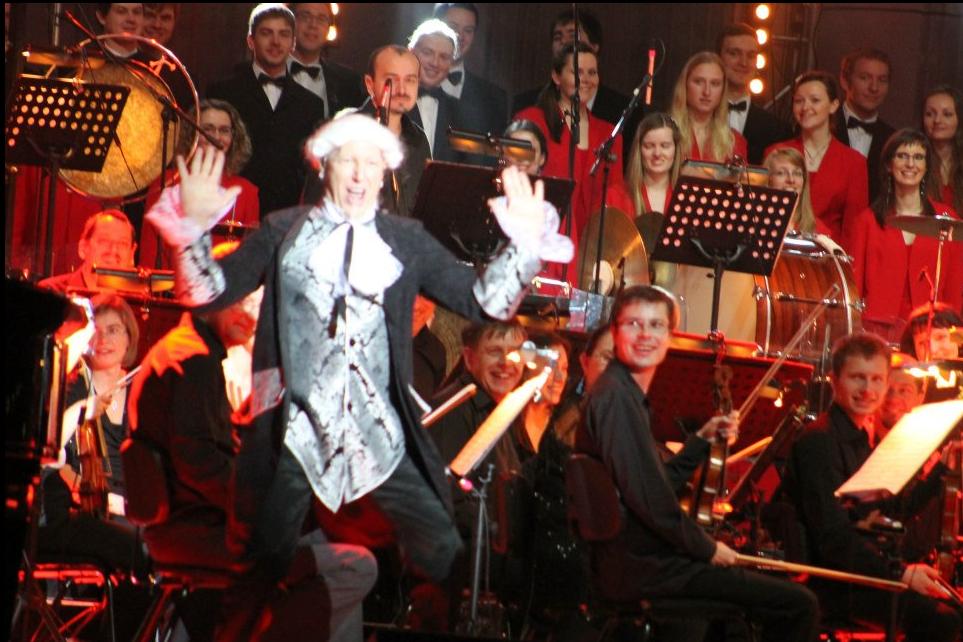TARJA TURUNEN & HARUS STORY
The hall darkens. An instant hush – and then, from above, there comes the stentorian, magisterial voice of the organ. Sitting behind it is Kalevi Kiviniemi, a man whose hands have graced some of the most unique, oldest and grandest of these instruments in the world, and whose career is spangled with a vast number of recordings and awards, marking him as Finland’s most distinguished organist. Below, on the left of the stage, Markku Krohn is almost hidden behind an array of chimes and kettledrums. The percussionist of Lahti Symphony Orchestra for over twenty years, he handles his instrument with a deft touch that provokes a bright, pleasing tintinnabulation, notes falling like the snowflakes that dust the wintry scene. From the other side of the stage follow the bold, shivering notes of the guitar. Marzi Nyman has a background in jazz, playing in the UMO Jazz Orchestra, alongside myriad other side projects and bands. His is a style that boasts a smooth, evocative charisma in place of barking riffs; the guitar sings in his hands, and the audience is firmly in thrall by the time the actual singer opens her lips. Tarja Turunen cuts a serene, gentle figure at centre-stage, a world away from the rock star image for which she became famous. The warmth carried on her voice spreads to every corner of the hall.
If this can be called a debut, then it has been five years in the making.
Everything was there, since the very beginning: four musicians, each an expert in their field and passionate about their art; a unique style; an enraptured following. In everything but name, Tarja Turunen & Harus have been a band since 2006. And yet its members were united as much by their hectic work schedules as their classical roots. It has taken this long, but the chrysalis is opening.
They first shared a stage in the summer of 2006 at Lahti Organ Festival. Working with each other was an opportunity they leapt for. Though their reputations preceded them, all nerves diminished upon that first meeting. On both a musical and a personal level, the kinship was instant and keenly felt, translating itself into a groundbreaking – and, more exhilaratingly, rule breaking – concert. The aptly named performance, ‘Crossover Organ’, veered between the traditional and the contemporary, boasting a bold and far reaching repertoire. The reverent splendour of Liturgical hymns was juxtaposed by the likes of Deep Purple and Nirvana. On paper, the chimeric progression and overlap of styles looked uncomfortable, unfathomable, more likely to provoke whiplash than anything else in the unsuspecting listeners. And yet… Classical music, the root and foundation of everything that followed it, runs like a river in the jungle of sound we inhabit today, sustaining the life of each branching subsidiary, the beating pulse that unifies every harmony we know. Genre boundaries were blurred and lost that night, but in their place something else was defined; a rich, eclectic and striking sound – the sound that was to create the band.
No work experimental and unpredictable in nature can hope for a predictable reception, and so it was all the more thrilling when the concert was met with a rising swell of applause, proving to be an unanticipated, yet liberating, success. Thus, with a vision shared between themselves and affirmed by hundreds of ears, it was not hard for the band to decide, “Hey, let´s do this again!”
The collaboration formed itself easily, brimming with talent, commitment and camaraderie. In 2008, they came together to perform a series of Christmas concerts in Finland, a tradition Tarja had begun a few years past and that they continue together to this day. Each year, the tetrad combed the breadth of their country, in annual tours that were becoming longer and longer. Despite the cold weather, churches were hot with the press of bodies, and when they were full, people crowded outside in the blistering December cold.
It was a project that none ever thought to nurture; it seemed simply to feed itself, strengthen itself, spreading wings that spanned the borders of Finland - and beyond. As the churches rang with hymns, and the winter air warmed with festive carols, a chord was struck in countless hearts – even those overseas. Travellers were appearing in increasing numbers from across oceans, just to sit in a pew under a vaulted roof for one night: simply to listen. For Tarja, seeing the interest and devotion they had somehow generated, even outside the country where they were performing, sparked a stark realization: here, poised atop its synergetic eyrie, a fully-fledged band was ready to take wing.
The knowledge was accompanied by a kinetic wave of excitement. “I wanted to bring it out of the shadows. I wanted to bring it closer to everyone.”
With that exact purpose in mind, it was her idea to make a recording of 2009’s concert in Lahti’s Sibelius concert hall, a beautiful building, and the biggest in Finland to be built from wood in over a century – a feature it can thank for its particularly impressive acoustics. Situated in the city where they first performed together, and with a capacity of just over one thousand, Sibeliustalo is the perfect venue for an intimate concert; a reflection of the harmony and solidarity that comes from five years of being almost a band. Blending – as ever – traditional and modern pieces, with arrangements and compositions from the band members themselves, this is not an introduction, but a wave to faces already familiar, a celebration of the magic these four have been conjuring since the beginning.
At the root of it all is a simple equation, a compound of four equal parts that breathes with rhapsodic innovation, unsurprisingly original, considering the musical alloys that are the band members themselves, their repertoires coloured with exotic, vibrant flavours, from jazz to heavy metal. It’s a harmonic mix, but challenging, too. Each instrument carries a strong presence. The imposing, majestic sound of the organ is a dramatic contrast to the sensual, modern ambience of the electric guitar; the gentle susurrus of chimes an unconventional compliment to the highly textured vocals. There is a fluidity common to all that unifies them into a single voice – but it can be offset by the simple surprise of hearing them together. Yet, the shocked expression of someone expecting something more traditional is one of the best kinds of feedback, at least according to Kalevi, who chuckles wryly, “That is how you know you’re making good music.”
Watching them onstage, one can see that this is where their real strength lies: in breaking boundaries; in freedom. There is no suppression of individuality here. Each player employs their own distinctive style. When each person shines, the resulting ensemble is effulgent. Classical they may be, but the band is anything but traditional.
Devising a name to summarize just that was not the easiest of tasks. Many less obscure suggestions were tossed into the air at the time of baptism. ‘Harus’ was an idea that appeared early in the brainstorming, but caused some consternation when it proved to be an ambiguous word, even to native ears. Yet it was the single name to which everyone returned. It is the guy-line securing the mast of a ship, the ropes that support any object being hoisted or raised, the four connecting wires that build the framework of a tent. ‘Harus’ means support, means balance, means strength. In essence, these individual artists are the four pillars that sustain their music.
“We all come from different backgrounds. We all have something different to give,” explains Tarja, “This is what really brings us together.” And together, like the gentle confluence of tributaries, these four have reached the boundless ocean.
“The combination is rare, and full of challenge.” Markku reflects, quietly and smilingly optimistic. “Let’s see what will happen in the future.”
It’s a journey that promises to be intrepid – but which we leave the cartographers themselves to navigate. The waters are unchartered, but the mast is strong. The horizon is limitless.

 Они же вчетвером и есть этот самый что-он-там-означает-этот-харус, так зачем выделять? Это похоже на то, как Марсело предлагал на dvd End of an Era написать "Тарья + Найтвиш".
Они же вчетвером и есть этот самый что-он-там-означает-этот-харус, так зачем выделять? Это похоже на то, как Марсело предлагал на dvd End of an Era написать "Тарья + Найтвиш".
 правда что ли?
правда что ли?






